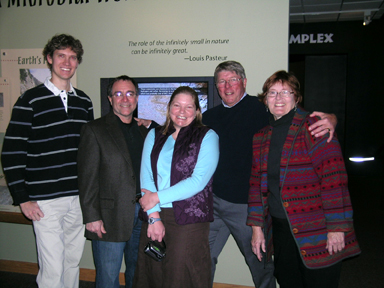Outreach Highlights
Earliest Life: A Microbial World
Earliest Life: A Microbial World is an exhibit funded by the Thermal Biology Institute. Dr Dave Ward worked with Museum of the Rockies staff to create an innovative addition to the preexisting permanent Landforms/Lifeforms exhibit at the Museum of the Rockies in Bozeman, Montana. The Landforms/Lifeforms exhibit chronologically explores Earth’s history from 4.6 billion years ago through the Paleozoic Era. Appropriately located in the Precambrian room of the exhibit, Earliest Life: A Microbial World focuses on the scientific evidence for the initial appearance of microscopic life on Earth about 3.5 billion years ago. The exhibit consists of several text panels, a touchable timeline with real fossils, a short video presentation on a flat screen monitor and two interactive touch screen programs. Through the text panels, time line and, reinforced by the video, visitors learn how the present is the key to understanding the past through research on existing microbial communities, such as those in Yellowstone hot springs, that is helping us to interpret fossil evidence of microbial communities from billions of years ago. The exhibit goes on to explore how studies of life in extreme environments inform astrobiologists about the possibilities for finding microbial life forms on other planets or moons. The interactive touch-screen programs give the visitor control over the learning experience and provide access to multiple levels of information about how DNA sequences of modern organisms can be used to construct a Tree of Life, providing a history of the evolution of life on Earth that is consistent with fossil evidence. The underlying theme of the exhibit is that tiny microorganisms were the dominant life form on this planet for 3 billion years, and still exist today as the unseen, yet dominant life forms maintaining a healthy Earth for all life forms.

Dr. Dave Ward and Museum of the Rockies staff pose in front of the Earliest Life exhibit during the grand opening at the MOR.
